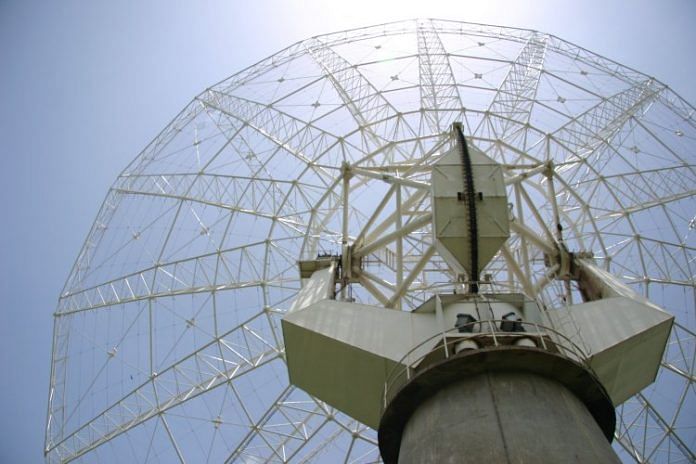The Giant Metre-wave Radio Telescope has singularly detected several record-breaking objects.
Bengaluru: A radio galaxy farther away than any discovered before was spotted recently by astronomers through the Giant Metre-wave Radio Telescope (GMRT) in Pune.
Radio galaxies are galaxies that have a large number of objects that emit radio waves.
The galaxy is located 12 billion light years away, and was discovered through the radio waves it emitted when the universe was just over 1.5 billion years old.
Headlines about the finding centred on the GMRT, which is operated by the National Centre for Radio Astrophysics (NCRA), a part of the Tata Institute of Fundamental Research (TIFR), Mumbai. So, what exactly is the GMRT, and how was the discovery made? ThePrint explains.
The GMRT is a radio telescope. As with most powerful telescopes, it comprises a group of dishes or an “array” that are all steerable and can turn their giant heads in any direction.
When all of GMRT’s 30 parabolic dishes point to the same source, the signal that’s received from the source is greatly amplified. This type of operation, where multiple antennae operate as one, is called interferometry.
Also read: When Nasa probe kisses the Sun, a star will spill long-held secrets
At the time it was built in 1995, the GMRT was the world’s largest interferometric array. Each dish is 45 metres in diameter, and the telescope is laid out in a Y configuration over 25 km in the 5,000-strong agricultural town of Khodad.
The telescope can be booked by teams or students wanting to use it by submitting a call for observation. GMRT allocates time to requests per semester, following the academic calendar. Depending on the kind of project for which it is required and the time availability, slots are carved out.
“There is also an option of director’s discretion time,” explained Abhijeet Borkar, a post-doctoral researcher in radio astronomy at the Astronomical Institute of Czech Academy of Sciences, with a master’s thesis from the NCRA, where he worked on the GMRT.
“If you want to make some important or immediate observations, and you can’t wait for the next cycle of proposal, then you can apply for this. Then the director decides if it is worth giving time,” he added.
Radio astronomy, where telescopes listen to radio signals from far-away sources, has helped detect astronomically significant events like quasars and gamma ray bursts. Arecibo in Puerto Rico, Acatama Large Millimeter/submillimeter Array (ALMA) in Chile, and the Very Large Array (VLA) in the US, have made notable contributions to the knowledge of astrophysical phenomena.
The GMRT is not behind in contributing significantly to radio astronomy, having singularly detected several record-breaking objects.
Last year, it helped discover one of the youngest known supernova remnants, aged only between 100 and 500 years. It has also studied the Sun intently. The GMRT has discovered multiple spinning neutron stars called pulsars that do full rotations in milliseconds.
It has discovered organic molecules at the centre of our galaxy, performed multiple sky surveys that search and record other events and objects, and has discovered “high red-shift galaxies”, i.e. galaxies that are moving away from us faster than any other known ones do.
Also read: Liquid water on Mars is no surprise but here’s why it makes the planet tougher to explore



